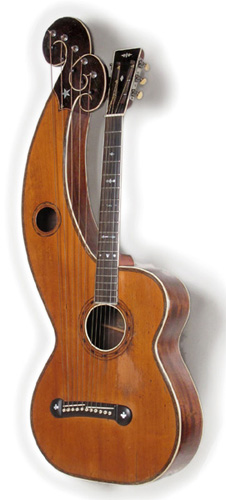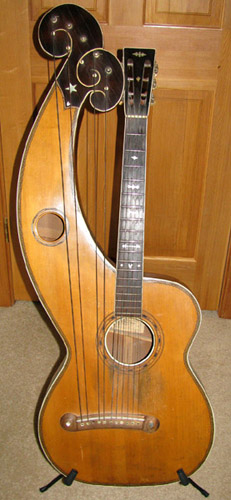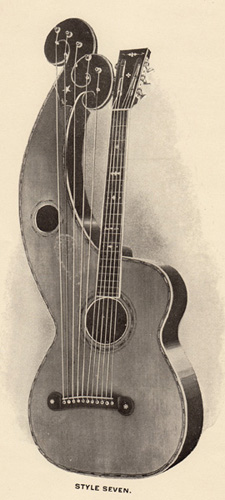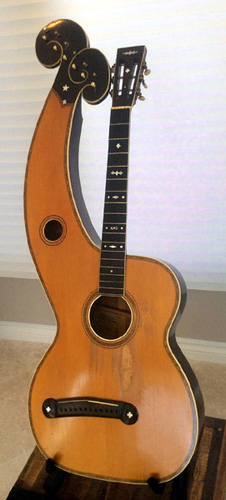
W.
J. Dyer & Bro. Symphony Harp Guitars
circa 1906 Catalog
by Gregg Miner
March, 2014
|
|
At last!
Larson brothers descendant and expert Bob Hartman has been
looking for a W. J. Dyer & Bro. (Dyer) catalog for 35 years now.
In March of 2014, he got his wish.
As it happens, of the few harp guitar catalogs the Dyer firm
produced, this one may not be quite the most important or exciting, but
it is nevertheless a prize for all aficionados of these popular
instruments. As with my Dating
page, this piece of ephemera required a lot of circular thinking and
research in order to date it. And
like my three possible Dyer Timelines, the exact appearance date and
period of this catalog remains a bit nebulous.
Though I state c.1906, it could possibly be earlier (c.1904), or
even later (though I highly doubt it). Below, I’ll look in detail at:
But tabling this investigation for later, let’s first take a look at this long-sought-after bit of ephemera!
The 24-page catalog measures 6” x 9” and has a beautiful Art Nouveau cover with metallic gold ink for the letters. |
|
|
Next − after a simplistic
explanation of four, five, and six string guitars, they mention their
“Symphony Harp Guitars with eleven strings” and that they were
“first introduced into the United States in 1899.”
Interesting! This is
almost certainly a reference to the date that Chris Knutsen first named
his 5-bass harp guitar the “Symphony” model.
Or it may represent the precise date that Dyer signed on to
distribute Knutsen’s harp guitars (see Jean
Findlay’s flyer). I
think it’s likely both − as the two events are thought to have
each taken place about 1899. Only
five subs are mentioned; there is no six-bass option anywhere in the
catalog. They next talk about the quality
of construction, referring to the subs as “contra bass strings,”
duplicating Knutsen’s own wording: “tuned to D, C, B, A and G, one
octave lower than regular pitch.”
On the following page, their boast about tone is, in retrospect,
an understatement! “The
rich, deep, sympathetic tone...is a revelation to those who have never
before heard them.” They,
like many other harp guitar builders, compare their instrument to an
“Italian Harp” in power (I so often see “Italian” – why?
Surely American harps like Lyon & Healy were by then far
superior?). |
||
|
Next come the harp guitar models, of which, sadly, there are only four. The Style 8, with its elaborate fingerboard inlay, had not yet made its appearance (nor had the 1908 harp mandolin). General specifications are as
follows: Style Four has a
spruce top with “mahogany finish” (obviously referring to the
stained top), while Styles Five,
Six and Seven have white
spruce (of increasing quality, they claim).
These three have “dark mahogany” (stained) back and sides
(the Style Four back and sides not stated).
Fingerboards are given as rosewood for the Style 4 & 5 and
ebony for the Style 6 & 7. All
are said to feature Spanish cedar necks, “ebonized” headstocks,
rosewood bass headstock veneer, ebony bridge and heel cap, bone nuts,
tempered German silver frets and nickel-plated patent tuning machines
“with detachable screw cogs.” Rosettes of “fancy colored
woods” are stated for all models for both soundholes, but only the
Style 7 shows this on the arm soundhole.
Though no binding is mentioned for the Style 5, the illustration
seems to show the expected ivoroid binding.
In an apparent printing mistake, they seem to have also used the
Style 5 engraving for the Style 4, which was never bound.
Additionally, this Style 5 illustration shows a bound bass
headstock, which is not described (nor found on extant specimens).
Take a look: |
|
|
|
The Style 6 lists “celluloid
bound body and scroll” – this could
include the back (as 6’s are usually found with, though not always
originally), but the angle of the engravings doesn’t show back binding
on any of the models (if it is
supposed to be there). It
also shows the 6’s expected narrow wood purfling border next to the
ivoroid, described as “elaborate wood inlaying.”
The bass head binding of (white) celluloid is listed and shown.
The Style 6 shows tiny pearl dots on frets 3, 5, 7, 10 and 12,
with double dots on frets 5 and 10 (the Style 5 shows single dots on
frets 5, 7 and 10). The Style 7 has all the bells and whistles we’re familiar with today (though not every element is described) – a more elaborate “colored wood inlaying,” fancy pearl fret markers (one of the “early Style 7” versions) and headstock inlay, pearl star and curlicue in bass head, pearl snowflakes in bridge filled with fancy bridge pins, and bound headstock and fingerboard. From what I’ve seen, the early Style 7 inlays were inconsistent – similar, and from the same stash of imported German pre-cut pearl patterns, but with some switching around amongst the frets. Headstock and bridge inlays similarly were slightly varied. Note the catalog Style 7’s “elaborate colored wood inlay”: the distinctive pattern of larger contrasted areas appears on both the soundhole and the body perimeter. However, I’m not sure if I’ve ever seen it on a specimen (other than the one pictured in the catalog testimonial photo below). The earliest 7’s have it on the soundhole, but just the more standard Style 6 type purfling on the body - while the only slightly later 7's have the more common purfling everywhere (though with the same general inlays). See below: |
||
 |
 |
 |
 |
 |
| Early 5-bass Style
7, label illegible (sold on Harp Guitar Music) |
Early 5-bass Style
7, ser #229? (courtesy anonymous owner) |
Early Catalog Style 7 | 6-bass Style 7, ser
#276 (courtesy JB Davies) |
6-bass Style 7, ser
#277 (from Chris J. Knutsen book) |
|
Each of the above photos will open in a new window for ease of comparison. You can see that the two 5-bass specimens on the left have the high contrast wood soundhole rosette like the catalog instrument (which was built; an exact duplicate appears in the historical photograph below); however, their body binding purfling is not the same. It's more like the normal binding of the two slightly later 6-bass specimens at right. You'll be able to easily see how every single instrument has at least one or two different inlays than the next... |
||||
|
An actual Style 7 specimen of the era next appears in a halftone of a young endorser; it seems to exactly match the earlier engraving. On the next page is another
photograph halftone of a mandolin quartet, with the harp guitarist
posing with an earlier Type 1 Dyer (with a strange bass head
interface/transition, it looks like a new specimen for us!).
Nowhere do they mention this earlier model, or what the photo is
doing in the catalog. The entire catalog is sprinkled
with testimonials, twenty-three in all.
Unfortunately, none of these letters include the date they were
written! Most of these
owners were direct sale customers. Two
testimonials provides provenance of a dealer middleman: The Butler Bros.
music house of Auburn, NY and S. C. Roberts Music House Co. of
Springfield, Mass. |
|
Not only is this catalog in great
condition (beyond the rusty nails), but tucked inside there was a
perfect unused order form and envelope! The double-sided order form (6”
x 9-½”) provides two date fields that, not surprisingly, are written
“190_” – no better dating help there!
Curiously, the form gives Dyer’s address as 21-23 West Fifth
Street (St. Paul, Minn.), while the envelope gives 21-23-25-27 West
Fifth. I know they expanded
their space (more than once?) at that address; perhaps a thorough search
of the city directories could help pinpoint the timeframe?
On the other hand, I’ve seen in Music Trade Review notices that
these numbers would come and go over this period (i.e.: not consistently
given in full). On the second side of the order
form is a section for “Easy Payment Plan”...which you could
basically fill out yourself, with your own terms!
(All you needed was the names of two “responsible business
men” to vouch for you) Though
I imagine that if you said “Style 7, with $1 down and 50 cents a month
until paid in full,” they’d probably write you back with a more
practical “counter offer”... Overall, this is a hundred+ year old treasure, and, I hope, not the last Dyer catalog we unearth. |
|
|
Dating As I said earlier, this catalog
is not easy to date. I
considered the obvious clues in the catalog itself (prices, 5 subs only,
no Style 8, number of testimonials), and compared these with clues (and
some harder evidence) in the BMG magazines (Cadenza, Crescendo, others).
Then I looked at our known serial number list, my three Timeline
options for that list, and specifically, two early 6-bass specimens, one a
Style 8 (curiously, the Dyer harp guitar with the thinnest body –
3-5/16” – ever found). The
fact that the Style Four’s $27.50 price kept being quoted through the
years was curious, as was considering lag time on a new catalog
creation/printing versus monthly advertisements.
Bob Hartman believes it could be c.1904, while I’m more inclined
to think c.1906, though I continue to vacillate.
The next question, regardless, would be how long did it last?
Perhaps until sometime in 1908, perhaps much longer?
These questions are probably only of interest to a few of us
diehard Dyer fanatics. In any
event, I prefer to be thorough, so prepared the following for reference: In the table below, I took all the entries from the (Members Only) BMG Magazines study and stripped them down to those with clues about catalogs. I include a “theoretical catalog count” and my interpretation of the clues and evidence. Catalog Crunching (from the available BMG advertisement evidence) |
|
| Cadenza/Crescendo Issue | Ad states: | The magazine editors state: | Theoretical Count | Interpretation | |
|
|
December, 1901 – August, 1903 (Cad) | “Send for illustrated circular and price list.” | Version 1 | The first "catalog" sounds like a simple flyer. | |
|
|
December, 1904 – January, 1906 (Cad) | “Write for catalogue No. 248.” | Version 2 | Almost certainly a new catalog, one that introduced the Type 2 harp
guitars.
The "No. 248" is a red herring, as a similar 1904 ad from a different magazine (Yale Scientific Monthly!?!) offered "catalogue No. 247." Like the use of a unique "Department so-and-so" in later ads, this was undoubtedly a similar common trick to track the source (and success) of advertisement placement. |
|
|
|
November, 1906 – August, 1907 (Cad) | "Write for Free Catalog" | Version 2 or 3 | This could have been the same 1904 catalog or a new one.
My vote: A new one, coinciding with the statements "Better than ever. 1906 model." As discussed in Dyer Dating, I still have no idea what "1906 model" might refer to. Remembering that there was an 8-month absence of Dyer ads before this new ad probably also meant that something was going on. A new catalog at this juncture seems natural. |
|
|
|
July – September, 1908 (Cres) | "Write for Free catalog" | The Cadenza stopped publication for the first 6 months of 1908,
after which it re-appeared under new ownership. Meanwhile, the
competing Crescendo magazine debuted in July, and featured a
typical Dyer harp guitar ad.
I don't believe there is anything significant about this Dyer period, the timing is due to the start of a new magazine. |
||
|
|
September–November, 1908 (Cad) | "Write for Catalogue and free trial plan" | Two years later, they could simply be using the same catalog (even
though these are important new ads), or a new catalog.
My vote: Either. If a new catalog was not yet ready, it would be soon (see further below). Note the October Crescendo quote (the harp guitar base price) of $27.50, the same as the extant catalog's Style 4 (see below also). |
||
|
|
October, 1908 (Cres) | "Price $27.50" | |||
|
|
December, 1908 – April, 1910 (Cad) | "Write for illustrated Catalog ..." | Version 3 or 4 | ||
|
|
December, 1908 – January, 1910 (Cres) | "Write for illustrated catalog." | |||
|
|
July, 1909 (Cres) | In Trade News, the editor states "We have recently received a fine illustrated catalog of the "Symphony" harp guitar manufactured by W. J. Dyer & Bro. The catalog contains a complete description of these popular instruments..." | This is the first dating evidence of a (presumably new) catalog being received (in this case by the Crescendo editor). Of course, it could have been available somewhat earlier (see above). | ||
|
|
April 1910 (Cres) | In Trade News, the editor says "...varies in price from $27 upwards. It has 5 extra strings..." | The Crescendo editor seems to be reading directly out of a Dyer catalog – presumably the one he announced in July 1909. Interestingly, his $27 price quote (for base price, presumably the Style 4) closely matches that of our "earlier" catalog. He also specifically gives only the five bass tuning. My interpretation: Dyer could have have kept their pricing the same (at least on the Style 4) for a few years. | ||
|
|
September, 1910 (Cres) | In the Q & A column, the Crescendo editor answers a reader with the same 5 bass tuning given in April. | My interpretation: Again, the editor is presumably referencing the same catalog, and has obviously not yet seen a 6-bass option. Perhaps this is because that even though Dyer was continually issuing new catalogs – and had been offering 6-bass options since at least late 1909 (and likely by 1908) – they didn’t think it important to mention the 6-bass option in catalogs? This would fit with the fact that they didn’t bother to mention a 6 bass option in their ads until 1917 (when it finally became “standard”), even though they had been predominately building and selling them that way since at least 1910. There is of course the possibility that the editor only did a casual perusal and just missed the (hypothetical) "stringing & tuning options" section, which may have mentioned the six-bass option. | ||
| 1911-1914 | ? | No particular mention of catalogs or other clues have been found. We can neither assume Dyer put out a new one, or continued with the 1908/1909 version. | |||
|
|
June, 1914 (Cres) | Mention is made of "the latest catalog of Symphony Harp-guitars" received at the Crescendo offices. | Version 4 or 5 | There doesn't seem to be any special reason to issue a new catalog in 1914, unless perhaps it had simply been too long without an update. This would also be just before Dyer's mysterious 31- month absence from both BMG magazines. | |
|
|
September, 1917 (Cad) | The Cadenza editor writes that Dyer has "just issued a new catalog" and that they "have recently added a tenor mandola and mandocello." | Version 5 or 6 | A brand new catalog would make sense here, as they had just finished creating their harp-mandolas and mandocellos (perhaps a clue to their 31-month ad disappearance?), which would appear next in their ads. | |
|
|
December, 1917 (Cad) | The Cadenza editor chose to write a second time about the impressive September catalog. | Clearly, they were impressed with the graphics in this last of the harp guitar catalogs! | ||
| September, 1919 (Cad) | Dyer ran various ads up through this month in The Cadenza. No further ads for harp guitars would appear. Presumably, one could still ask for a copy of the last catalog. | ||||
| 1923 | Full Catalog | The Music Trade Review announces a new Dyer catalog that includes every conceivable instrument that the firm was then selling...but no mention of harp guitars. That doesn't mean they weren't still included (see below). Presumably, Dyer offered a catalog of their full line since the beginning of their business. | |||
|
|
1939 | Full Catalog | Another full Dyer catalog was issued, and amazingly, included an updated harp guitar ad, listing a couple with different model numbers. No such labelled "styles' have ever been found, and presumably, none were ever built or ordered at this late date. |
Next, here’s a look at our early known serial numbers
within my three Dating Systems (Timeline A removed, I believe Bob
Hartman now prefers C):
|
||||||||||||||||||||||||||||||||||||||||||||||||||||||||||||||||||||||||
|
If you enjoyed this article, or found it
useful for research, please consider making a donation to The
Harp Guitar Foundation, |
|
|
|
All Site Contents Copyright © Gregg Miner,2004-2020. All Rights Reserved. Copyright and Fair Use of material and use of images: See Copyright and Fair Use policy. |